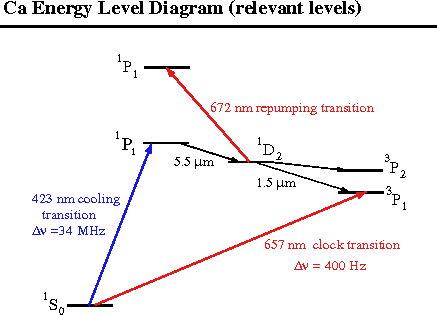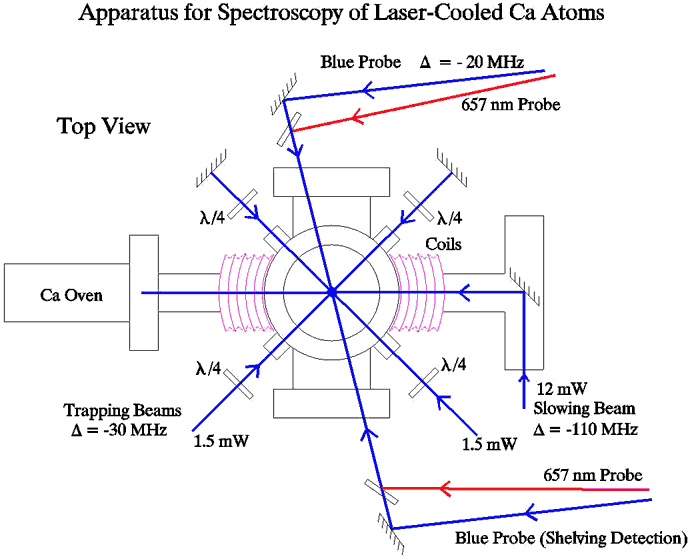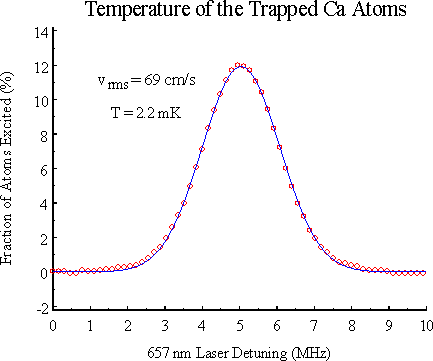


|
|
|
|
A
compact calcium magneto-optic trap
|
|
|
|
|


Introduction
As we set out to construct a relatively compact magneto-optic trap (MOT) for Ca, we were faced with two main challenges. One was to construct a diode-laser-based system to generate sufficient light power at 423 nm for excitation of the 1S0 → 1P1 cooling transition.� A second was to find a simple MOT design which would work efficiently for Ca. Unfortunately, the simplest form of atom trap, the vapor cell MOT, is difficult to apply to alkaline earth atoms such as Ca due to the high temperatures (>300�C) required for adequate vapor pressure. For this reason, the first Ca MOTs were loaded with atoms from Zeeman-slowed atomic beams. While these traps performed well, they were large and required strong magnetic fields. We decided to try instead a modified version of a trap design which was first demonstrated for lithium at Stanford (see Brian P. Anderson and Mark A. Kasevich, Phys. Rev. A 50, R3581 (1994)) and subsequently for Ca at PTB and NIST. This design forgoes the use of the Zeeman slower and relies instead on catching only the slow atoms from the atomic beam. To compensate the reduced velocity capture range, we place the trap as close to the atomic source as possible, so as to have a large atom flux through the trapping region.
In
our present version (see the figure below) the trap center is located 13 cm
from the oven. The oven, which we operate at ~600�C, has a nozzle (1 mm diameter, 1 cm long) which serves as the
only beam-collimating aperture in the system. The cylindrical vacuum
chamber of the trapping region (10 cm in diameter) has eight windows in
addition to entry and exit ports for the atomic beam. Four of these
windows are set in the horizontal plane at 45�
relative to the atomic beam. There is a pair of larger horizontally
oriented windows (perpendicular to the atomic beam) which are
anti-reflection-coated for 657 nm and 423 nm to transmit red and blue
probes. We use a pair of vertically oriented windows for trapping beams
and fluorescence collection. Due to the broad trapping transition, the
trap requires a large magnetic field gradient (

With about 10 mW per retroreflected vertical beam and 2 mW for the retroreflected horizontal beam, we can trap ~106 atoms in 20 ms for a trap detuning of -30 MHz (see photograph at top of trapped atoms scattering trapping laser light). The trap lifetime is limited to ~20 ms by optical pumping to the 1D2 state (see the level diagram), from which an atom decays 25% of the time to the extremely long-lived 3P2 level, and thus falling out of the trap. Otherwise an atom will decay to the 3P1 level and back to the ground state on a time scale (3.5 ms) which gives a good probability for recapture. We have been able to increase the trap lifetime (and thus the equilibrium trap number) by as much as a factor of 9 by optically pumping atoms out of the 1D2 state with light from an additional diode laser at 672 nm (see the level diagram at top).
Another approach for increasing the equilibrium number of atoms is to increase the loading rate by accessing a larger portion of the atomic beam’s velocity distribution. To this end we have added a slowing beam tuned 110 MHz below resonance, which is aligned counter-propagating to the atomic beam. Interestingly, we find the greatest increase in trapped atom number when we transfer most of the power from the trapping beams (still detuned 30 MHz to red of the transition) to the slowing beam. Our present version uses ~12 mW in the slowing beam and ~1 mW in each trapping beam. Even without a special Zeeman slower, this beam still slows enough atoms in 13 cm that our loading rate increases by an order of magnitude. With our modified "loaded" trap, we can accumulate ~107 atoms in 70 ms. In fact, though they are far from optimal for slowing the atomic beam, our large diameter trapping coils act as a crude Zeeman slower. The evidence for this is that we see an improvement (x2) in the loading rate when we switch the polarization of our slowing beam from linear to the "correct" circular. Conversely, we see no increase in the loading rate for the opposite circular polarization.

The resultant temperature for our cold Ca sample is typically a few mK, much larger than that for alkali atom traps. This is a consequence of the lack of Zeeman structure in our J=0 ground state, which precludes sub-Doppler cooling mechanisms. Furthermore, the large linewidth of the cooling transition leads to a large Doppler-cooling limit, which for Ca is 0.8 mK, corresponding to a root-mean-squared velocity (vrms) of 42 cm/s. We can readily measure the velocity distributions of our cold atoms using the first-order Doppler shift on the narrow red transition. In the figure above we show a typical velocity distribution, measured for a trapping laser detuning of -28 MHz. This lineshape closely resembles a thermal distribution with a vrms of 69 cm/s, corresponding to a temperature of 2.2 mK. These comparatively warm temperatures for alkaline atom cooling have important implications for our spectroscopic investigations.